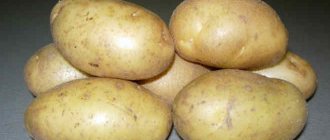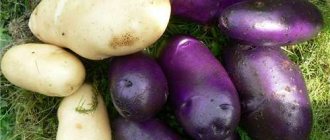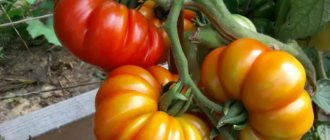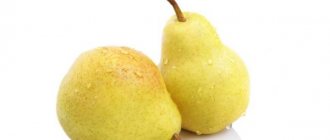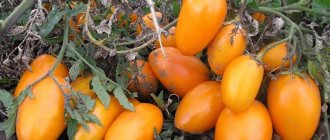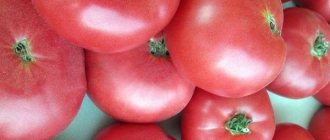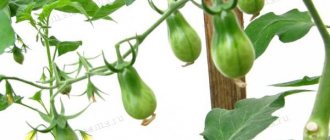The Sorokodnevka potato is an ultra-early variety with a growing season of 40 days. Well-formed, ripe tubers can be harvested 40 days after planting. But it is worth taking into account the peculiarity of the culture; the taste of new potatoes will be pleasant, but not as rich as that of the late variety.
Magpie is a variety that boasts good resistance to unstable weather and various diseases. The yield is extremely high, and if you use additional methods to increase the yield, you can achieve amazing results.
Description and characteristics of Sorokodnevka potatoes
- The tubers of these varieties are average. The minimum average weight is 80 g, and the maximum is 120 g.
- The tubers have an oval shape, maybe more round.
- The peel has a light, uniform color. It feels rough to the touch. The color of the peel can be pink or yellow, depending on the characteristics of the variety.
- The pulp has a characteristic creamy tint.
- There is little starch in one tuber. On average, its share in Sorokodnevka potatoes is 14%.
- The varieties belonging to this group are famous for their high content of protein and amino acids, which, along with beta-carotene, play an important role for human health.
The concept of Sorokodnevka includes many varieties of folk selection that did not manage to get into the official State Register. The Sorokodnevka potato, its detailed description of the variety, a number of features, photos from gardeners and reviews from farmers give a complete picture and a better understanding of the culture. Potatoes are most often used by small farmers or owners of small summer cottages. It is not profitable to grow the variety for industrial purposes.
Potatoes Sorokodnevka, according to the description of the variety and many photos, have small bushes. They often grow spreading with dark green leaves. A characteristic feature of the leaf is the waviness of the edge. The corolla is formed from white flowers that quickly fall off.
May grass will feed the hungry
So, day after day, and May has already arrived. If the air temperature is high enough, stop covering the potato bed with film. Systematic loosening of the soil and the war against weeds - we continue.
Around the second half of May, the forty-day plant will begin the flowering phase. Some “experienced” gardeners recommend completely tearing off flower stalks, they say, this increases the yield of tubers. In fact, this fact is absolutely unconfirmed. During the experiments, agronomists found that neither the number of bulbs formed nor their size depends in any way on the presence of flowers. Moreover, injury to potato bushes by tearing off flower stalks can lead to an extension of the ripening period of the crop.
So, let’s leave the flowers where they are and get on with more important things.
Blooming plantation
(Illustration source: www.legom.info)
While our potato bed is getting ready to “beautify”, we carry out a second feeding and re-hilling. The forty-day-old plant has already begun to grow bulbs, so we again sprinkle each bush with a handful of nitrophoska and rake a hump around it to thoroughly cover the root part of the plant.
By the end of May, you can notice the first invaders on potato leaves - Colorado potato beetles and their larvae. In principle, the potatoes have very little time left to ripen - about 2-3 weeks, so the presence of this voracious evil spirits will have minimal impact on the yield. Nevertheless, he is taking emergency measures and declaring a mortal battle against the Coloradans. If the bed is not large, shake the insects into a bucket with a regular broom, simultaneously destroying the eggs that these creatures like to lay on the inside of the leaves. If you have a plantation of impressive size, you cannot do without chemicals.
Most early potato varieties are resistant to the Colorado potato beetle, so the intensity of the “fighting” depends on the specifics of the variety you choose.
Advantages and disadvantages of the variety
Gardeners who cannot grow many varieties due to the unstable climatic conditions of the region can easily grow any ultra-early variety, because this kind of potato can give excellent results under temperature changes and in infertile soils.
If the climate of the region is warm, then Sorokodnevka potatoes can be grown several times a year.
Some gardeners manage to plant it and reap a good harvest three times. The composition of the soil will mainly determine the volume of the harvest. But on average, one hectare can yield 300 centners of tubers. Important! It is difficult to call Sorokodnevka a stable variety. Tubers of the same variety can be different, large and small, which are not suitable for planting. But there are few deformed tubers.
Growing and care
Potatoes are planted in prepared soil and fertilized in the fall or spring. The holes are dug at a distance of 35-40, leaving approximately 70 centimeters between the rows. The holes are dug shallow, and wood ash can be added to them when planting. Planting work is carried out in April, but by this time the weather should have improved and the soil should warm up to 15-18 degrees. It should be noted that early varieties are afraid of frost. If the weather begins to deteriorate and frosts are expected at night, then the plantings should be covered with film or covering material at night.
May be interesting Potatoes "Karatop" - productive, early, tastyIs it possible to treat potatoes during flowering against the Colorado potato beetle Variety of potatoes "Arosa": ripening, taste, storage
Before carrying out work, planting material is sorted out, healthy tubers with sprouts of at least two centimeters are selected. Then they are pickled and treated with growth stimulants. Large potatoes can be cut into two parts. A few days before planting, it is hardened in the fresh air, and then planted. Sprouts appear approximately two weeks after planting. After 6-8 leaves are formed on the bush, hilling is carried out, and then fertilizers are applied. They hill up and feed for the second time a month later. Potatoes respond well to organic as well as mineral fertilizers. At first, if there is precipitation, the plants do not need watering. Particular attention should be paid to removing weeds, as they take away all the beneficial substances from the soil. Loosening the soil is carried out once every two weeks, watering if necessary once or twice a month. Two weeks before harvest, watering is stopped.
On a note!
When growing any potatoes, you must follow the rules of crop rotation.
Harvesting is carried out manually, tubers for eating are dug up 40-50 days after planting, and those that will be planted next year are left to ripen for another 10-14 days. Forty days old is not suitable for storage; it is eaten within a month after collection or processed. After a month it will begin to wither and rot. Tubers for planting are dug up, dried and stored in a dark, dry room. In regions with warm climates, forty days old can be grown up to three times per season.
Sorokodnevka varieties
The Sorokodnevka potato variety is represented by the following species.
- Timo - copes well with low temperatures, produces high-quality fruits without additional measures to stimulate productivity.
- Karatop - despite the small mass of tubers, the variety has become popular. This is a bright representative of German selection, characterized by a high level of productivity.
- Meteor is a variety that calmly tolerates long periods of drought and rarely suffers from late blight. It has become popular among Russian farmers due to its unique taste, excellent marketability and excellent keeping quality. Despite the fact that many ultra-early varieties are recommended not to be stored and consumed soon after harvest.
- Impala is a popular variety among gardeners in the southern regions; it allows you to harvest twice an excellent harvest in a year.
- Scarlet is an early ripening potato from the forty-day group that tolerates transportation well due to its relatively dense peel. It is famous for its ability to be stored for a long time.
- Kholmogory variety is an ideal variety for table purposes with excellent taste and delicate aroma. This is a hybrid that is capable of retaining its best qualities for a long time under ideal storage conditions.
- The new variety is considered to be an ultra-early, robust variety that is distinguished by excellent marketability.
Correct fit
The first step in growing potatoes is proper preparation of the land for planting. The plant's growing season is early, so it is necessary to prepare the soil in advance:
- Humus is introduced, after which the soil is dug up. It is advisable to do this in the fall, because laying humus in the spring can damage the potato tubers.
- It is recommended to plant potatoes in the area where parsley, dill, legumes, pumpkin, and cereals grew. It is not advisable to plant after nightshades.
- The bed is marked into rows up to 80 cm wide between each other. In a row, at a distance of 30 cm, make depressions up to 10 cm. A little vegetable compost is poured into the holes.
Before planting, it is advisable to bring the potatoes for several days into a warmer room than where they were stored all winter. In the warmth, small seedlings will begin to appear in the eyes of the potatoes, this is the signal to start planting. With this method, we can clearly see whether all the potatoes are ready for planting.
If the month of April is not cold, there are no frosts, we proceed to planting:
- We harden the tubers for several days, take them out into the fresh air, if there is a lot of planting material, simply open the door in the room to allow fresh air to enter;
- One potato at a time is placed in the holes;
- It is covered with earth, slightly compacting it.
Characteristics
“Sorokodnevka” fully ripens within 40-50 days, the timing depends on the variety and region of growth. Suitable for cultivation both on site and on small farms, as well as in industrial facilities. Ultra-early ripening potatoes are only suitable for storage for a short period of time; they are eaten immediately after harvest and processed.
The starch content in tubers is from 11 to 16%, so potatoes are suitable for preparing any home-cooked dishes. The bushes are low-growing and also tall, the amount of foliage on them is moderate, and the flowering period is short. On one plant, tubers of different sizes, large and small, are formed. Potatoes are not suitable for long-distance transportation.
Any potato has its own positive and negative qualities. Each variety has its own specific agricultural technology; this must be taken into account when choosing.
Advantages:
- early maturation;
- good yield indicators;
- excellent taste of young tubers;
- plantings are rarely affected by late blight, since the crop is dug up before the peak of this disease;
Flaws
- Harvesting can only be done by hand, since most varieties have thin skin;
- The forty-day period is not suitable for storage; only planting material is stored until spring;
Note! Most diseases and pests are not harmful to early potatoes. The point is not even in natural immunity, but in the fact that pests and diseases become active only in the middle of summer, and by this time the harvest is already harvested.
Diseases and pests
In general, Karatop has an excellent immune system that protects it from most diseases and pests, for example: high resistance to viruses Y and A, late blight of tubers, glandular spot, scab, blackleg, verticellosis, alternaria and others.
The only exception is late blight of tops, to which Karatop has rather weak resistance.
Therefore, as a preventive safety measure, during the appearance of buds, you should spray your bushes with systemic contact fungicides.
ATTENTION! An infusion of garlic and potassium permanganate would also be a good preventive remedy.
You can see options for combating late blight in this video:
The history of the origin of the Krona potato variety
The Krona potato variety was developed by breeders from Germany. It is widespread in most European countries.
The year of entry into the State Register is 2015.
The table below presents data on the yield of other potato varieties:
| Name | Variety | Productivity |
| Nikulinsky | Late ripening | From 170 to 300 centners per hectare. |
| Cardinal | Late ripening | From 200 to 350 centners of potatoes are harvested from 1 hectare. |
| Rocco | Late ripening | From 350 to 400 centners per hectare. |
| Kiwi | Late ripening | From 1 kg of planting tubers it reaches 20 kg. |
| Picasso | Late ripening | From 1 hectare about 20 tons. |
| Borovichok | Early ripening | 200-250 centners per 1 hectare of land. |
| Elmundo | Early ripening | 250-350 centners per hectare. |
| Felox | Early ripening | 250 centners per hectare. |
| Bellarosa | Early ripening | The harvest from one bush is 8-10 tubers. |
| Natasha | Early ripening | From 130 to 190 centners per hectare. |
| Forty days | Extra early | Up to 300 centners of potatoes are harvested from one hectare of soil. |
| Karatop | Extra early | From 18.5 to 27 tons per hectare (Middle Volga region), from 20 to 43.5 tons per hectare (Northwestern region). The maximum yield is 50 tons per hectare. |
| Riviera | Extra early | After the first digging on the 45th day after the emergence of potato shoots, it ranges from 134 to 225 centners per hectare. The maximum yield by the end of the growing season reaches 450 centners per hectare. |
| Zhukovsky early | Extra early | The harvest from one bush is up to 15 tubers. |
| Minerva | Extra early | Fertile soils allow you to harvest the first harvest of up to 230 centners per hectare. By the end of the growing season (45-50 days), the maximum yield is achieved - up to 430 centners per hectare. |
| Crane | Mid-late | 640 centners per hectare. |
| Sorcerer | Mid-late | Productivity varies from 27 to 35 tons per hectare. |
| Mozart | Mid-late | The average yield is approximately 430 c/ha. |
| Grenada | Mid-late | From one hectare you can harvest up to 60 tons of potatoes. |
| Ramona | Mid-late | The yield is consistently average from 10 to 15 tons per hectare. |
| Yanka | Mid-early | The average yield ranges from 195 to 315 centners per hectare. |
| Giant | Mid-early | The average harvest ranges from 290 to 424 centners per hectare. |
| Tuscany | Mid-early | Productivity varies from 210 to 400 centners per hectare. |
| Purple Haze | Mid-early | Productivity varies from 182 to 309 centners per hectare. |
| Santana | Mid-early | The average yield varies from 164 to 384 centners per hectare. |
“Krona” is recommended for industrial cultivation, breeding on farms and on personal plots. Most Russian regions are suitable for cultivation.
How to harvest and store crops
Early ripening Spring begins to be harvested in early June, and in some regions a little later. Potatoes should be dug on dry soil. If you do not plan to eat the tubers immediately, then they need to be dried outside in the shade.
Storage features and keeping quality of the Sorokodnevka variety
Potatoes will not spoil and will be preserved for a long time if they are dried and stored in wooden boxes. This storage allows the tubers to “breathe”. In addition, dry peel is the key to the absence of rot. Storage temperature should be no more than 12 °C.
If tubers are immediately selected for planting next year, they should be dried in the sun. This will allow them to absorb everything they need for a good harvest.
July – the beauty of summer, the middle of color
In the second half of July, the remaining forty days should be removed from the garden. By that time, the potato tops will have already dried out, and the bulbs will have formed a dense skin. We cut off the above-ground part of the plants, leave the bed alone for 5-6 days and dig the potatoes out of the ground. We carefully dry the planting material, sort it and send it for storage in a dry, well-ventilated room. And in the spring we plant them in the garden again.
Unfortunately, the forty-day period pleases us with a fresh harvest for only 1 month. But this also has its advantages. Firstly, already in June you will enjoy the mind-blowing taste of new potatoes, and secondly, after forty days you will still have time to grow a late harvest of dill or parsley in that same garden bed. So, don't despair. Moreover, by the end of July, beginning of August, both medium and late-ripening potato varieties will delight you with young potatoes.
Plavinsky N.K.
Dangerous insects: killer bees and tiger bees
The process of growing a crop
Zorachka Potatoes
Spring potatoes need to be planted in open ground. It is best to grow root vegetables in areas where potatoes have not been cultivated for 3 or 4 years. It is preferable to plant pure-grade tubers weighing 70-100 grams. For planting, take only whole potatoes, without cuts.
Whole potatoes for planting
Note! The more living (not dried) eyes on a potato, the greater the likelihood that the result will be a large, lush bush with the maximum number of root crops.
To obtain high yields, follow the following planting rules:
- Experienced vegetable growers recommend planting potatoes after winter crops, flax, annual or perennial grasses, legumes, lupine (on sandy soils). This is important for maintaining crop rotation. Only then can you get a rich harvest of early potato varieties 40 days old;
- Choose a well-lit area, and right before planting, dig it up to the depth of one bayonet shovel and thoroughly loosen the soil with a rake;
- Then you need to mark the bed into rows with an interval between them of 75-80 cm;
- Dig small holes in the row (about 7-8 cm), with a distance of 30 cm between them;
- You need to fill the bottom of the hole with high-quality humus. Never fertilize with fresh manure. Planting material is very sensitive to unrotted manure;
- Place one potato in each hole and cover it. For prevention, it is better to treat seed root crops before planting with copper sulfate (1 teaspoon per 3 liters of water). To eliminate rust on tubers, root-feed the plantings with a superphosphate solution (3 tablespoons per bucket of water);
- The optimal temperature for effective development of root crops is from 18 to 22C.
Important ! Any deviations from the optimal temperature have a bad effect on the yield of root crops.
Care instructions
- Timely loosen the soil between rows and rows with the appearance of the first shoots;
- Control weeds using any convenient method. A very popular method is mulching;
- Apply fertilizing (nitrophoska) and carry out hilling after the first leaves appear;
- Additional watering only if necessary. Usually in the spring there is enough melt water for the entire short growing season of the plant.
Additional Information. Even if you plant an early ripening root crop in early May, the harvest will still be ready by mid-June. Therefore, there is no need to rush planting and expose the root crops to the risk of freezing.
